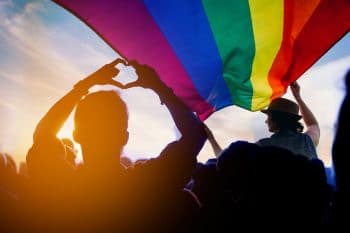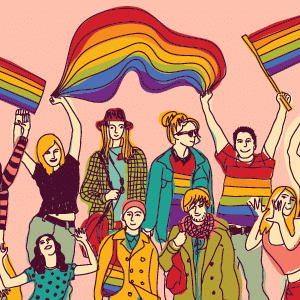Opioid Addiction In The LGBTQ+ Community

The Scope of Opioid Addiction in the LGBTQ Community
The lesbian, gay, bisexual, transgender, and queer community has, historically, suffered higher rates of substance abuse compared the general population. As the Opioid Epidemic has grown in the United States, LGBTQ Americans similarly have faced growing rates of addiction and fatal overdose. To date, there has been scant research about rates of Opioid addiction in the LGBTQ+ community. Yet, surveys do demonstrate the outsized effects of Opioids on these individuals.
Among LGBTQ adults between 35 and 44 years old, 58% had received an Opioid prescription, compared to just 35% of the remaining population.
Compared to the approximately 9% of the overall population that engages in substance abuse, between 20% and 30% of the LGBTQ+ community abuse drugs or alcohol. Also, compared to 4.5% of the total population, LGBTQ rates of Opioid addiction are considerably higher. Among adults over 18 years-old who misused prescription Opioids (such as Hydrocodone or Vicodin®) in the past year, the LGBTQ+ community accounted for 10.4% (or 1 in 10). Moreover, they are nearly 3 times as likely to develop an Opioid addiction than heterosexual adults.
LGBTQ Opioid Addiction Statistics
In 2015, 10.4% of LGBTQ over the age of 18 reported misusing prescription Opioids.
Men who have sex with men (MSM) are 9.5 times more likely to abuse Heroin than men who do not.
In a recent study of addiction treatment services, only 7.4% had LGBTQ-specialized services.
Minority Stress and Other Factors Leading to Addiction
While the LGBTQ community shares some risk factors that contribute to developing an Opioid addiction with the general population, certain factors are specific to their unique, and oftentimes traumatic, experience in America. Psychologists describe “minority stress” as the primary, specific factor that typically wounds LGBTQ people. According to the National LGBT Health Education Center, minority stress is “everyday discrimination, marginalization, and victimization based on their sexual and gender minority statuses.” Minority stress contributes heavily to the initiation of substance abuse and the onset of a Substance Use Disorder (SUD).
External stigma can become internalized, leading to identity concealment, self-hate, feelings of worthlessness, and fear of rejection. To escape or mute these challenging emotions, some LGBTQ people turn to Opioids and other substances that provide a sense of euphoria or relief.
National LGBT Health Education Center, 2018

In addition to (and in part caused by) the unfair discrimination they commonly face, transgender people are at a significantly higher risk for Opioid addiction. As gender affirmation surgery becomes more accessible, so too do the prescription of medication pain relievers following surgery. Also, transgender men and women (as well as older people living with HIV) report more chronic pain than other groups, and are thus more likely to receive an Opioid prescription. Because Opioids carry such a high risk of addiction, normal use as prescribed by a doctor can result in a physical dependence on painkillers. Ultimately, an Opioid dependence will result in withdrawal symptoms when usage stops. To prevent painful withdrawal symptoms, many people turn to illicit Opioids like Heroin and Fentanyl. Both are more powerful and less expensive than pills like OxyContin® or Ultram® (Tramadol).
Opioid Addiction Effects Among Specific LGBTQ Groups
Lesbian and bisexual women |
Abuse substances at quadruple the rate of heterosexual women.
11.6% misused prescription Opioids in the past year in 2015, compared to 3.7% of heterosexual women. Are more likely to self-medicate with Opioids. |
Gay and bisexual men |
14.2% misused prescription Opioids in the past year in 2015, compared to 5.4% of heterosexual men.
Men who have sex with men are 9.5 times more likely to have used Heroin than heterosexual men. Are more likely to abuse substances for the high or to “have a good time”. |
Transgender men, women, and youth |
Transgender children and adults are more likely to have more severe levels of depression and other co-occurring mental health issues that can lead to substance abuse.
Transgender high school students are twice as likely to misuse prescription Opioids and three times as likely to misuse any Opioid (including Heroin). |
Lesbian, gay, and bisexual youth |
Bisexual teens abused substances 3.4 times more often than heterosexual young people in 2015.
14.2% of LGB youth between 18 and 25 years old misused painkillers in the past year in 2015. |
Co-occurring Mental Health and Behavioral Disorders
Often, addiction exacerbates symptoms of mental health illnesses (such as depression and Post-Traumatic Stress Disorder, or PTSD). Likewise, untreated mental health disorders can drive a person to self-medicate by taking drugs with the hope of feeling better. Consequently, co-occurring (also known as co-morbid) disorders are relatively common to those suffering from a SUD, due to overlapping factors that make up an individual’s behavioral and mental health. The gay and transgender communities, however, are disproportionately affected by mental health disorders – caused by the minority stress and discrimination described above.
People in the LGBTQ+ community are more likely than their heterosexual counterparts to enter treatment with higher levels of depression and suicidal thoughts and engage in more self-harm. In addition to Opioids, they are also more likely to abuse other drugs (such as Amphetamines and Cocaine) and drink more heavily. Such substance abuse contributes to the development of additional co-occurring SUDs – each requiring a specialized detox plan in order to recover.
Addiction Treatment for the LGBTQ+ Community

For the start of any Opioid addiction treatment program, medication-assisted therapy (MAT) is recommended in conjunction with detox and therapy. Yet, a scarcity of access to health insurance and discrimination in employment (where most Americans get their healthcare coverage) prevents many LGBTQ community members from getting the treatment they need. Nearly twice as many gay and lesbian adults – compared to the overall population – go without health insurance; rates for bisexual and transgender adults are even higher. Furthermore, ill-equipped rehab programs and some co-occurring disorders like HIV and PTSD make finding suitable treatment challenging for LGBTQ+ adolescents and adults.
Risky behaviors like sharing needles and unprotected sex put some in the LGBTQ community at heightened risk of contracting HIV and Hepatitis.
Though the gender and sexual minority (GSM) community more often enters rehab with higher-severity cases of addiction, the National Institute on Drug Abuse points to some evidence-based therapy methods proven effective against chemical dependency. They include:
- Motivational interviewing – technique to resolve insecurities and find internal motivation necessary to change damaging behaviors
- Social support therapy – can be emotional support, tangible aid, advice, or providing information that prompts self-assessment
- Contingency management – provides incentives to change negative behaviors and reinforce positive ones
- Cognitive behavioral therapy (CBT) – focuses on recognizing inaccurate patterns of thinking and the foundations that created them, then forming coping strategies
- Cognitive processing therapy (CPT) – used to recover from trauma and PTSD
Fundamentally, addiction treatment for GSM youth and adults needs to provide specialized care that meets the needs of the community. Staff should be trained in use of proper pronouns as well as how to fully eliminate terms that highlight harmful stigma and stereotypes.
Will Treatment Interfere With Hormone or Antiretroviral Therapy?
Some gay and transgender patients delay seeking addiction treatment because they fear it might interfere with their hormone therapy or antiretroviral therapy (ART). For instance, Efavirenz® (an ART medication) has known interactions with Opioid MAT like Methadone and Buprenorphine. However, co-prescribing MAT with ART or PrEP medication is safe, life-saving, and viable with the proper supervision and follow-ups by a doctor.